Serviços Personalizados
Journal
Artigo
Indicadores
-
 Citado por SciELO
Citado por SciELO -
 Acessos
Acessos
Links relacionados
-
 Similares em
SciELO
Similares em
SciELO
Compartilhar
Silva Lusitana
versão impressa ISSN 0870-6352
Silva Lus. vol.21 no.1 Lisboa jun. 2013
Tree Modeling and Economic Evaluation of Agroforestry Systems in Southeastern Brazil
Modelagem de árvores e avaliação econômica de sistemas agroflorestais na região sudeste do Brasil
Modélisation de arbres, et évaluation économique des systèmes agroforestiers dans le sud-est du Brésil
*Sílvio Nolasco de Oliveira Neto, **Thiago Taglialegna Salles,***Helio Garcia Leite, ****Gabriel Borges Ferreira e *****Raul César Nogueira Melido
* Associate Professor, Departamento de Engenharia Florestal, Universidade Federal de Viçosa, Avenida P. H. Rolfs, s/n - Campus UFV, 36570-000, VIÇOSA (MG), BRASIL; E-mail: snolasco@ufv.br
** Doctoral candidate, Departamento de Engenharia Florestal, Universidade Federal de Viçosa, Avenida P. H. Rolfs, s/n - Campus UFV, 36570-000, VIÇOSA (MG), BRASIL; E-mail: thiagotsalles@gmail.com
*** Associate Professor, Departamento de Engenharia Florestal, Universidade Federal de Viçosa, Avenida P. H. Rolfs, s/n - Campus UFV, 36570-000, VIÇOSA (MG), BRASIL; E-mail: hgleite@gmail.com
**** Forest Engineer, KTM Administração e Engenharia, Avenida David Jonas Fadini, 1.672 - Juca Rosa, 45.823-431, EUNÁPOLIS (BA), BRASIL; E-mail: gabriel.bf@hotmai.com
***** Forest Engineer, Votorantim Siderurgia, Zona Rural, Caixa Postal 04 , 38780-000, Vazante (MG), BRASIL; E-mail: raul.melido@vsiderurgia.com.br
ABSTRACT
In this study, the authors aimed to apply a consistent, efficient and biologically correct model to estimate growth and yield of the tree component from eucalypt-based agroforestry systems and, through economic indicators, analyze and evaluate its products. The systems were composed by hybrid clones of Eucalyptus spp. in 10 x 4 m spacing, integrated with rice, soybean and pasture. The equation system developed by CLUTTER (1963) was used as the starting point for estimating growth and yield of Eucalyptus wood. The model application resulted in accurate estimates for both basal area and future volume, with adjusted coefficient of determination of 0.908 and 0.956, respectively. The economic criteria used in the analysis were the internal rate of return (IRR), the net present value (NPV), the equivalent annual value (EAV) and the benefit-cost ratio (B/C) with discount rates of 6, 8, 10 and 12 %. The agroforestry systems were economically viable considering all studied indicators and discount rates. Lastly, changes in the discount rate affect the systems profitability, so that the lower the rate, the higher the economic return.
Key words: agrosilvopastoral system, forest inventory, forest economy
RESUMO
Neste estudo, os autores buscaram aplicar um modelo consistente, eficiente e biologicamente correto para estimar crescimento e produção do componente arbóreo de sistemas agroflorestais baseados em eucalipto e, através de indicadores econômicos, analisar e avaliar seus produtos. Os sistemas foram compostos por clones híbridos de Eucalyptus spp. em espaçamento de 10 x 4m, integrados com arroz, soja e pasto. O sistema de equações desenvolvido por Clutter (1963) foi usado como ponto de partida para estimar crescimento e produção de madeira de eucalipto. A aplicação do modelo resultou em estimativas precisas tanto para área basal quanto para volume, com coeficiente de determinação ajustado de 0.908 e 0.956 respectivamente. Os critérios econômicos utilizados nas análises foram a taxa interna de retorno (TIR), o valor presente líquido (VPL), o valor anual equivalente (VAE) e razão benefício-custo (B/C) com taxas de desconto de 6, 8, 10 e 12%. Os sistemas agroflorestais foram viáveis economicamente considerando todos os indicadores e taxas de desconto estudadas. Por fim, mudanças na taxa de desconto afetam a rentabilidade dos sistemas, sendo que, quanto menor a taxa, maior o retorno econômico.
Palavras-chave: sistema agrossilvipastoril, inventário florestal, economia florestal
RESUMÉ
Dans cette étude, les auteurs ont cherché à utiliser un modèle cohérent, efficace et biologiquement correct pour estimer la croissance et la production du composant arboricole de systèmes agroforestiers ayant pour base leucalyptus, et, à travers des indicateurs économiques, analyser et évaluer ses produits. Les systèmes ont été formés par des clones hybrides dEucalyptus spp. avec des écarts de 10 x 4 m, complémentés avec du riz, du soja et du foin. Le système déquations développé par Clutter (1963) a été utilisé comme point de départ pour estimer la croissance et la production de bois deucalyptus. Lapplication du modèle a abouti à des estimations précises tant pour laire de la base que pour le volume, avec un coefficient de détermination ajusté de 0.908 et 0.956, respectivement. Les critères économiques utilisés dans les analyses furent le taux interne de retour (TIR), la valeur liquide présente (VPL), la valeur annuelle équivalente (VAE) et le quotient bénéfice-coût (B/C), avec des taux de réduction de 6, 8, 10 et 12%. Les systèmes de lagroforesterie ont été économiquement viables eu égard à tous les indicateurs et taux de réduction étudiés. Finalement, des changements dans le taux de réduction affectent la rentabilité des systèmes, étant donné que, plus le taux est bas, plus grand sera le retour économique.
Mots clés: système agrosylvopastoral, inventaire forestier, économie forestière
Introduction
In recent years, due to worldwide concern about environment preservation and conservation, great attention has been given to the sustainable exploration of natural resources. Sustainable exploration can guarantee productive potential of such resources maintaining life expectancy of actual and future generations. Agroforestry systems (AFS) are considered an alternative use of natural resources that usually causes little or no environmental degradation, especially because it respects the basic principles of sustainable management of agroecosystems (MACEDO et al., 2000).
Agrisilviculture provides income with agricultural species management during forest growth period and generates jobs in the countryside. Despite being a system that aims agricultural and forest products, there are environmental benefits resulting from the better occupation of the site: carbon sequestration, soil protection, regulation of water regime and increase on species diversity (VALE, 2004).
AFS helps to conserve and protect natural resources by, for example, mitigating non-point source pollution, controlling soil erosion and creating wildlife habitat. Agroforestry creates economic and environmental benefits. AFS may increase farm profitability because it generates new products add to the financial diversity and flexibility of the farming enterprise, and the total output per unit area of tree/crop/livestock combinations is greater than any single component alone (MOLUA, 2005).
In Brazil several experiences have shown the potential of the Eucalyptus genus to compose agroforestry systems (OLIVEIRA et al., 2000; MACEDO et al., 2006; MACEDO et al., 2010). The first records about consortium between agricultural crops and eucalypt were made in the beginning of the century, being mentioned by ANDRADE & VECCHI (1918), ANDRADE (1928) and later, in the work of GURGEL FILHO (1962).
As said by MOLUA (2005), there is need to investigate the economic nature and profitability of agroforestry. Though there are multiple functions for agroforestry systems, the economic incentives derived could be catalytic in encouraging adoption.
DUBÈ et al. (2000) carried out an analysis of the economic aspects of a eucalypt-based agroforestry system established at the Brazilian savanna and showed that this system was economically more attractive than a monoculture. The region of study, allocated in the Northwest of the Minas Gerais state, has been target of researches related to agroforestry since the end of the 1990s. DUBÈ et al. (2002) applied a simulation model to evaluate technical and economic aspects of the agroforestry system there established. At the same site, SOUZA (2005) used a model to predict the yield of eucalyptus clones. However, the model used by the author did not express increasing wood volumes proportionally to the increase in local production capacity (site index), resulting in lower volumes at more productive locations when compared with less productive places.
According to VAN der WERF et al. (2007), long term yield predictions are needed to assess long term economic profitability of AFS. Also, financing mechanisms are essential to promote and accelerate the adoption of these systems on a large scale. In this context, economic evaluations are important supporting tools to financing agents, technicians and producers involved in this type of investment (SANTOS & PAIVA, 2002; PATTANAYAK et al., 2003; BENTES-GAMA et al., 2005; MARTHA JUNIOR et al., 2011).
The present study was also conducted with data of an agroforestry system located at the Northwest of Minas Gerais state, Brazil. The AFS included the cultivation rice, soybean, pasture and eucalypt.
The wood from commercial eucalypt plantations in Minas Gerais state has been used mostly for energy (in the form of charcoal) and sawn wood. The state stands as the largest producer and consumer of charcoal, as it has the largest steel making industry fueled by charcoal in the world. This fact contributes to the participation of the forest sector in 7% of the states GDP (SANTOS et al., 2012). Regarding the sawn wood, household consumption corroborates with the increase in the demand for eucalyptus wood, since the supply of native woods, mainly due to legal restrictions, tends to decrease (VALVERDE et al., 2004).
The region has tradition in cattle and grain production. The soils of the sites have generally low natural fertility (SOUZA et al., 2010). This scenario justifies the inclusion of rice in the first year, since this culture is less demanding on fertility. The soybean, introduced in the second year, benefits from the residual fertilizing of the rice and also improves fertility for the pasture aiming cattle fattening
In this scenario, the objectives of this study were: apply a consistent, efficient and biologically correct model to estimate growth and yield of the tree component from eucalypt-based agroforestry systems and, through economic indicators, analyze and evaluate its products.
Material and methods
Site and agroforestry systems characterization
The data for this research were obtained from agroforestry systems belonging to the unit Votorantim Siderurgia from Votorantim Enterprise Corporation, located in the municipality of Paracatu (17°1300 S and 46°5200 W), northwestern Minas Gerais state, Brazil (Figure 1). Its Brazils largest AFS, covering about 1,500 ha. These systems are one of the most intensively managed in Brazil, providing to be an example of best practices for agrosilvopastoral systems (CUBBAGE et al., 2012).
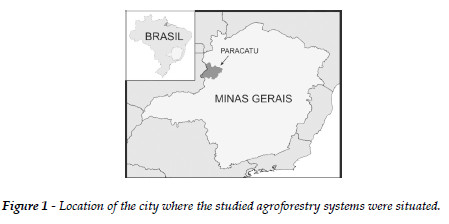
The regions climate is Aw – humid tropical savanna, according to Köppen classification. Mean maximum annual temperature is 28 °C and mean minimum annual temperature is 17 °C. The mean annual precipitation is 1,350 mm, concentrated at the hottest semester. The driest month presents precipitations lower than 25 mm and the driest period is from April to October. The annual potential evaporation varies between 1,200 and 1,600 mm (INMET, 2013).
The average altitude is 550m and the relief varies from plain to slightly wavy. The soil is classified as dystrophic Red-Yellow latosol, clayey texture (16.25% of sand, 21.50% of silt and 62.25% of clay), with low fertility and high acidity.
The vegetation is composed by Brazilian savanna in several topologies, varying from fields to Brazilian savanna woodland and subperennial riparian forests, mainly in the extremities of rivers, developed on soils derived from basalt (GOLFARI, 1975).
The agroforestry systems adopted by the enterprise since 1993 were characterized by a stand of hybrid clones ofEucalyptus spp. integrated with rice (Oriza sativa L., Guarany cultivar), soybean [Glycine max (L.) Merr., Doko, Conquista and Vitória cultivars] and grass (Urochloa brizantha), in a defined time scale, aiming the production of wood for charcoal and lumber, agriculture products and beef.
The eucalyptus clones were planted in a 10 X 4 m spacing to allow agricultural cultivation between the rows in the first two years. The planting of rice was carried out in the first year, while soybean culture was added in the second year. The spacing in the rice and soybean plantations was 0.45 m between lines, using 80 and 24 seeds per linear meter respectively. To avoid competition, a minimum spacing of one meter was held between the lines of eucalypt and the lines of rice, soybean and grass.
The pasture formation began in the third year with the planting of Urochloa brizantha and as from the fourth year, steers were acquired for fattening, establishing sale of cattle every 2 years. Other details of these systems, mainly concerning about soil preparation, fertilization, silvicultural practices and production, can be found in the works of DUBÈ (1999) and TSUKAMOTO FILHO (2003).
The data for modeling was obtained from 17 permanent plots of 30 x 40 m (1,200 m²) containing three rows of 10 trees. They were implanted taking into account the criteria of continuous forest inventory by stratified random sampling, with an intensity of 1:10 (one plot for each 10 ha).
Eucalyptus growth and yield modeling
To include the timber production in the economic analysis, the forest component of the systems was modeled by fitting the Clutter model as seen in SALLES et al. (2012). The author successfully applied the non-reduced form of the model to estimate growth and yield of agroforestry systems at the same Brazilian region. The equation system on its non-reduced form is defined:

where I1 is the current age, in months; I2 is the future age, in months; B1 is the basal area at age I1, in m2.ha-1; B2 is the basal area at age I2, in m2.ha-1; S1 is the site index at age I1; V2 is the volume at age I2, in m3.ha-1; ßi and ai are the model parameters; and e is the random error, where e ~ N (0, s2).
The pairs of the variables I1 and I2 used on the fitting were: 20-35, 21-34, 21-42, 31-46, 32-47, 33-54, 34-41, 35-42, 43-58, 46-53, 47-54, 55-70, 58-65, 69-82, 70-77 and 82-89 months. The site index (S1), also called production capacity, was generated by the guide-curve method through the equations obtained by LOPES (2007), whose work was carried out in the same location as the present study. Based on the observed amplitude of the S variable, three classes of productivity were defined: S=32 for good sites, S=22 for average sites and S=12 for poor sites.
The trends between lnV2 and its predecessor variables were examined via scatter plots. It was seen that lnV2 increases with increasing S1, lnB2, S1lnB2 and lnB2I2-1, and decreases with increasing I2-1 and S1I2-1. Therefore, it was expected negative signs for the coefficients ß1 and ß4 and positive for the others.
In addition to the usual t test, to assess the significance of the model parameters, it was verified the hypothesis of the absolute value of each parameter being greater than two times its respective standard error. If so, their estimate was considered reliable at 95% confidence level (p = 0.05). This method is based on the t-statistic, which is given by the ratio between the estimated value of the parameter and its standard error.
The equation system was fitted by the two stages least squares (2SLS) method, using the software EViews 3.0 (LILIEN et al., 1998). The 2SLS consists on two successive applications of the ordinary least squares (OLS) method. In the first stage, the parameters of the equation (1), formed by the endogenous variable as a function of the other exogenous variables in the system, are estimated. In the second stage, the estimated values of the endogenous variable ??obtained in the first step are used to estimate the structural equation (2) (GUJARATI, 2004).
Economic analysis
The methodology used for the economic evaluation of the agroforestry systems was based on the study developed by DUBÈ (1999). It was assumed that 60% of the wood produced would be used for charcoal production and 40% would be used in sawmills. Moreover, the selling prices were considered as being of standing timber, getting the operating, transportation, carbonization and sawmill costs on the buyer. The selling prices were equal to 35.09 US$/m³ for the charcoal production wood and 43.86 US$/m³ for the sawmill wood. The monetary values corresponding to July 2008 were compiled from information given by the company (Tables 1 and 2). The values in Brazilian Real were converted to American Dollar based on the average quote during 2008.
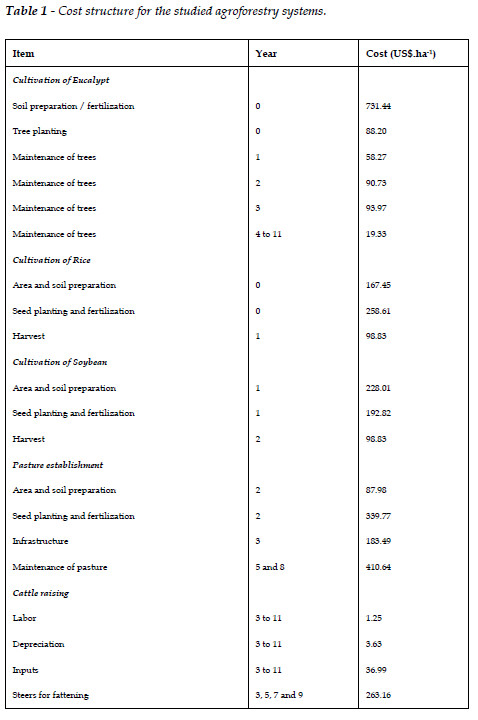
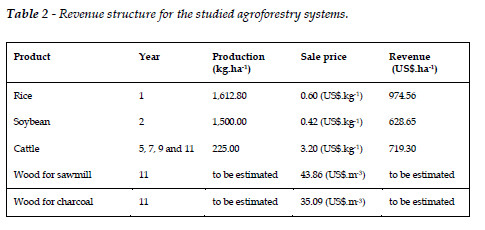
The economic criteria used for the analysis were the net present value, equivalent annual value, benefit-cost ratio and internal rate of return. The discount rates of 6, 8, 10 and 12% per year were established to perform a sensibility analysis involving the proposed indicators. These are the rates that comprise most studies involving agroforestry systems in the Brazilian forestry sector (DUBÈ et al., 2000; OLIVEIRA et al., 2000; BENTES-GAMA et al., 2005; MÜLLER et al., 2011). The expressions for calculating the economic criteria were:
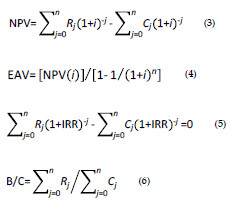
were NPV is the net present value; EAV is the equivalent annual value; IRR is the internal rate of return; B/C is the benefit-cost ratio; R is the total revenue in year j; C is the total cost in year j; i is the annual discount rate; and n is the project duration, in years.
Results and discussion
Eucalypt growth and yield modeling
The adjusted coefficient of determination () referring to the basal area equation (B2) was equal to 0.908, and the adjusted coefficient of determination referring to the volume equation (V2) was equal to 0.956.
The parameters estimates whose absolute values were higher than twice their standard errors and had signals as expected were considered significant at 95% probability. Also, all the estimates were significant by the t-statistic (p = 0.01). The final equations were composed with those parameters (Table 3).

For the basal area equation, the a1 parameter was not significant, removing the site variable from the final expression. Similar results were found by VALDEZ-LAZALDE & LYNCH (2000), DIAS et al. (2005), GEORGENS et al. (2007) and OLIVEIRA et al. (2009). Different values of B1 at 12 months were set, according to the observed data, to generate consistent B2 estimates for the different classes of site index.
The model is usually applied in the reduced form obtained by Clutter (1963), who fitted equations (1) and (2) to a sample of Pinus taeda trees. Nevertheless, SALLES et al. (2012) using the Clutter model to estimate growth and yield of agroforestry systems showed that the reduction of the model based on the fitting made to a sample of the target population is a better alternative than using the pre reduced form. The results shown here support this idea, since the final equation system on Table 3 was different from all equation systems obtained by SALLES et al. (2012).
The volume curves (Figure 2) passed through the points that express the volume in the three observed productivity classes. This situation indicates that the model represented with accuracy the scenario observed in the field. Also, the residual distributions obtained from the estimations, had deviations lower than 20%. These values ??are related to good estimates for eucalyptus monoculture (CRUZ et al., 2008; ARAÚJO JÚNIOR et al., 2010; ZONETE et al., 2010). When there is lack of accurate estimates for an agroforestry system, managers usually use literature and experiments data (BERTOMEU, 2006). This sometimes may generate untrustworthy feasibility analysis, as discussed by SALLES et al., (2012).
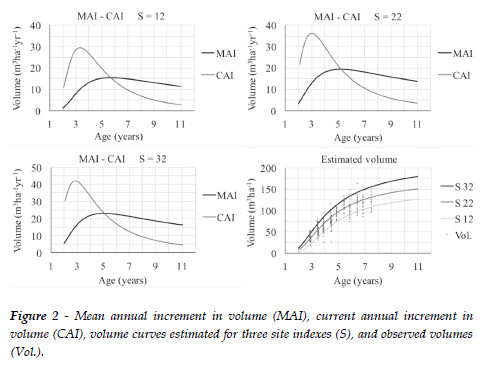
It is important to note that the volume equation was applied in the form:
V2=exp(ß0 + ß1I2-1 + ß4S1I2-1 + ß5S1lnB2 + ß6lnB2I2-1). Therefore, the volume curves presented the exponential tendency seen in Figure 2.
Considering that the technical cutting age occurs when the forests MAI (Figure 2) reaches its maximum and touches the curve of CAI, it is seen that the model was consistent when estimating this attribute, since lower technical cutting ages were obtained at sites of higher production capacity. For the site indexes 12, 22 and 32, the cutting ages were 68, 63 and 60 months respectively (Table 4). These values are in accordance with the results achieved by LOPES (2007), who fitted a diametric distribution model adapted from the one proposed by NOGUEIRA (2003), using data from the same region as the present study. According to the author, the cutting ages were compatible to the average rotation of conventional plantations (monocultures), suggesting that despite the large spacing, competition occurs at the plantation line.
Economic analysis

The cash flow covering the 11 years had positive accumulated balance only at the end of the last year (Table 5). This occurs because these AFS are a long term investment with a long time of capital conversion, mainly considering that the highest revenue (which comes from the wood cut) occurs in the end of the 11th year. In agreement with this scenario, MÜLLERet al. (2011) studying an agrosilvopastoral system in Brazil, came to the conclusion that its viability depends mostly on its forest products.
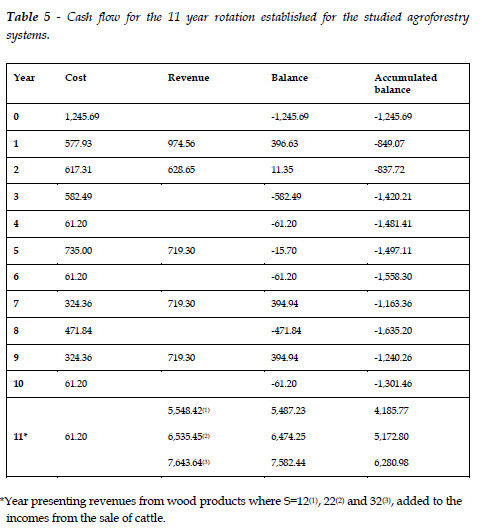
The results of the economic analysis using the estimates from the Clutter model were consistent. With increasing productive capacity, the economic parameters (NPV, EAV and B/C) also increased (Table 6). From the balances in year 11, it can be seen that forestry is the portion that carries most revenue to the systems.
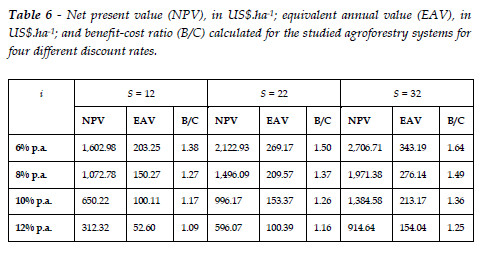
For the low, average, and high productive classes (site indexes 12, 33 and 32), the internal rates of return (IRR) were 14.35%, 16.14% and 17.88% respectively. Based on this indicator, the agroforestry systems adopted by the company were economically viable for all the discount rates used in the sensitivity analysis. They were also viable based on NPV, EAV and B/C to all discount rates in the simulations. In all cases, the NPV and the EAV were positive and the B/C was higher than 1.
MÜLLER et al. (2011), studying an agroforestry system in Brazil (also in the state of Minas Gerais) came to positive but more modest feasibility results when compared with the present study. In his work the economic analysis involved three different alternatives to the sale of wood. The values ??of NPV in US$.ha-1 were 576.12, 740.00 and 871.66, and the alternatives were feasible for discount rates lower than 10.0%, 11.0% and 11.7%.
The results confirm agroforestry as a good investment. The values ??of NPV and B/C are similar to those obtained by RASUL & THAPA (2006) who found that the activity brings good social and economic benefits when compared with other traditional land use.
The impact of competition cannot be ignored in these systems. The effects of the soybean and rice over the eucalypt are minimized through the control zone of one meter maintained between the cultures and the trees (DUBÈ, 1999). Regarding the pasture, its competition with eucalypt is higher in the younger ages of the trees. As the pasture is sown when the eucalyptus is already two years old, the impacts are minimal (TOLEDO et al., 2000). There are also the effects of the eucalyptus shading over the pasture. The Urochloa brizantha is a forage species with moderate tolerance to shading and presents satisfactory nutritional value after its growth when planted between the rows of the 10 x 4 spacing (OLIVEIRA et al., 2007).
The techniques here utilized, involving economic indicators, are better suited to answering specific questions rather than producing generalized assessments. They are especially important when using agroforestry as a development tool in the tropics or economic tool in temperate zones (MONTAMBAULT & ALAVALAPATI, 2005).
Conclusions
This study gains importance by containing incipient information for decision making in the management of agroforestry systems in Brazil, once the adoption of AFS is happening in various regions as a result of financial support such as the Low Carbon Agriculture Program from the Brazilian government.
The results obtained in this study lead to the conclusion that the Clutter model used in the way showed by Salles et al. (2012) produces consistent estimates of growth and yield to be applied in economic analysis. The systems adopted by the company are economically viable when considering the criteria: NPV, EAV, B/C and IRR.
Forestry is the main source of economic revenue in the systems. However, wood has shown strong price variation in Brazil. Thus, the cattle become important in the systems because it generates income and prevents that all the revenue occur at the end of the cash flow.
References
ANDRADE, E.N., 1928. O eucalipto e suas aplicações. São Paulo: Typografia Brasil de Rothschild & Cia. 143 pp. [ Links ]
ANDRADE, E.N. and VECCHI, O., 1918. Os eucaliptos: Sua cultura e exploração. São Paulo: Typografia Brazil de Rothschild & Cia. 238 pp. [ Links ]
ARAÚJO JÚNIOR, C.A., NOGUEIRA, G.S., OLIVEIRA, M.L.R.de, MIRANDA, R.O.V.de, CASTRO, R.V.O., PELLI, E., 2010. Projeção da distribuição diamétrica de povoamentos de eucalipto em diferentes amplitudes de classe. Pesquisa Agropecuária Brasileira 45(11) : 1275-1281. [ Links ]
BENTES-GAMA, M.M., SILVA, M.L.da, VILCAHUAMÁN, L.J.M., LOCATELLI, M., 2005. Análise econômica de sistemas agroflorestais na Amazônia Ocidental, Machadinho DOeste-RO. Revista Árvore 29 (3) : 401-411. [ Links ]
BERTOMEU, M., 2006. Financial Evaluation of Smallholder Timber-based Agroforestry Systems in Claveria, Northern Mindanao, the Philippines. Small-scale Forest Economics, Management and Policy 5(1) : 57-82. [ Links ]
CLUTTER, J.L., 1963. Compatible growth and yield models for loblolly pine. Forest Science 9(3) : 354-371. [ Links ]
CRUZ, J.P.da, LEITE, H.G., SOARES, C.P.B., CAMPOS, J.C.C., SMIT, L., NOGUEIRA, G.S., 2008. Curvas de crescimento e de índice de local para povoamentos de Tectona grandis em Tangará da Derra, Mato Grosso. Revista Árvore 32(4) : 679-685. [ Links ]
CUBBAGE, F., BALMELLI, G., BUSSONI, A., NOELLEMEYER, E., PACHAS, A.N., FASSOLA, H., COLCOMBET, L., ROSSNER, B., FREY, G., DUBE, F., SILVA, M.L.da., STEVENSON, H., HAMILTON, J., HUBBARD, W., 2012. Comparing silvopastoral systems and prospects in eight regions of the world. Agroforestry Systems; Published online : 1-12. Url: http://dx.doi.org/10.1007/s10457-012-9482-z. [ Links ]
DIAS, A.N., LEITE, H.G., COUTO, L., FERREIRA, A.C., 2005. Emprego de um modelo de crescimento e produção em povoamentos desbastados de eucalitpo. Revista Árvore 29(5) : 731-739. [ Links ]
DUBÈ, F., 1999. Estudos técnicos e econômicos de sistemas agroflorestais com Eucalyptus sp. no Noroeste do Estado de Minas Gerais: O caso da Companhia Mineira de Metais. MSc Dissertation, Universidade Federal de Viçosa, Viçosa, Brazil, 146 pp. [ Links ]
DUBÈ, F., COUTO, L., GARCIA, R., ARAÚJO, G.A.A., LEITE, H.G., SILVA, M.L.da, 2000. Avaliação econômica de um sistema agroflorestal com Eucalyptus sp. no noroeste de Minas Gerais: o caso da Companhia Mineira de Metais. Revista Árvore 42(4) : 437-443. [ Links ]
DUBÈ, F., COUTO, L., SILVA, M.L., LEITE, H.G., GARCIA, R., ARAÚJO, G.A.A., 2002. A simulation model for evaluating technical and economic aspects of an industrial eucalyptus-based agroforestry system in Minas Gerais, Brazil. Agroforestry Systems 55(3) : 73-80. [ Links ]
GEORGENS, E.B., LEITE, H.G., NOGUEIRA, G.S., DIAS, A.N., 2007. Tendência de crescimento de povoamento de eucalipto após aplicação de desbaste. Revista Árvore 31(5) : 879-885. [ Links ]
GOLFARI, L., 1975. Zoneamento ecológico do estado de Minas Gerais para reflorestamento. Technical series. Belo Horizonte, PNUD/FAO/IBDF, CPFRC, 65 pp. [ Links ]
GUJARATI, D.N., 2004. Basic Econometrics. United States Military Academy, West Point, McGraw Hill Publications. [ Links ]
GURGEL FILHO, O.A., 1962. Plantio de eucalipto consorciado com milho. Silvicultura em São Paulo 1(1) : 85-102. [ Links ]
INMET - Instituto Nacional de Meteorologia, 2013. Normais Climatológicas do Brasil 1961-1990. Published online. Url: http://www.inmet.gov.br. [ Links ]
LILIEN, D.M., STARTZ, R., HALL, R.E., ENGLE, R., ELLSWORTH, S., NOTH, J., SUEYOSHII, G., 1998. EViews: Econometric Views. Quantitative Micro Software. v. 3.0. [ Links ]
LOPES, P.F., 2007. Modelo de distribuição de diâmetros para clones de eucalipto em sistema agroflorestal. MSc Dissertation, Universidade Federal de Viçosa, Viçosa, Brazil, 32 pp. [ Links ]
MACEDO, R.L.G., BEZERRA, R.G., VENTURIN, N., VALE, R.S., OLIVEIRA, T.K., 2006. Desempenho silvicultural de clones de eucalipto e características agronômicas de milho cultivados em sistema silviagrícola. Revista Árvore 30(5) : 701-709. [ Links ]
MACEDO, R.L.G., VALE, A.B.do, VENTURIN, N., 2010. Eucalipto em sistemas agroflorestais. Lavras: UFLA. 331p. [ Links ]
MACEDO, R.L.G., VENTURIM, N., TSUKAMOTO FILHO, A.A., 2000. Princípios de agrossilvicultura como subsídio do manejo sustentável. Informe Agropecuário 21 : 93-98. [ Links ]
MARTHA JUNIOR, G.B., ALVES, E.R.deA., CONTINI, E., 2011. Dimensão econômica de sistemas de integração lavoura-pecuária. Pesquisa Agropecuária Brasileira 46 : 1117-1126. [ Links ]
MOLUA, E.L., 2005. The economics of tropical agroforestry systems: the case of agroforestry farms in Cameroon. Forest Policy and Economics 7 : 199-211. [ Links ]
MONTAMBAULT, J.R., ALAVALAPATI, J.R.R., 2005. Socioeconomic research in agroforestry: a decade in review. Agroforestry Systems 65 : 151-161. [ Links ]
MÜLLER, M.D., NOGUEIRA, G.S., CASTRO, C.R.T.de, PACIULLO, D.S.C., ALVES, F.de F., CASTRO, R.V.O., FERNANDES, E.N., 2011. Economic analysis of an agrosilvipastoral system for a mountainous area in Zona da Mata Mineira, Brazil. Pesquisa Agropecuária Brasileira 46(10) : 1148-1153. [ Links ]
NOGUEIRA, G.S., 2003 Modelagem do crescimento e da produção de povoamentos de Eucalyptus sp. e de Tectona grandis submetidos a desbaste. DSc Thesis, Universidade Federal de Viçosa, Viçosa, Brazil, 145 pp. [ Links ]
OLIVEIRA, A.D., SCOLFORO, J.R.S., SILVEIRA, V.P., 2000. Análise econômica de um sistema agro-silvo-pastoril com eucalipto implantado em região de cerrado. Ciência Florestal 10(1) : 1-19. [ Links ]
OLIVEIRA, M.L.R., LEITE, H.G., NOGUEIRA, G.S., CAMPOS, J.C.C., 2009. Modelagem e prognose em povoamentos não desbastados de clones de eucalipto. Revista Árvore 33(5) : 841-852. [ Links ]
OLIVEIRA, T.K.de, MACEDO, R.L.G., SANTOS, Í.P.A.dos, HIGASHIKAWA, E.M., VENTURIN, N., 2007. Produtividade de Brachiaria brizantha (Hochst. ex A. Rich.) Stapf cv. Marandu sob diferentes arranjos estruturais de sistema agrossilvipastoril com eucalipto. Ciênc. agrotec. 31(3) : 748-757. [ Links ]
PATTANAYAK, S.K., MERCER, D.E., SILLS, E., YANG, J-C., 2003. Taking stock of agroforestry adoption studies. Agroforestry Systems 57 : 173-186. [ Links ]
RASUL, G., THAPA, G.B., 2006. Financial and economic suitability of agroforestry as an alternative to shifting cultivation: The case of the Chittagong Hill Tracts, Bangladesh. Agricultural Systems 91 : 29-50. [ Links ]
SALLES, T.T., LEITE, H.G. OLIVEIRA NETO, S.N.de, SOARES, C.P.B., PAIVA, H.N.de, SANTOS, F.L.dos, 2012. Modelo de Clutter na modelagem de crescimento e produção de eucalipto em sistemas de integração lavoura-pecuária-floresta. Pesquisa Agropecuária Brasileira 47(2) : 253-260. [ Links ]
SANTOS, R.C.dos, CARNEIRO, A.de C.O., TRUGILHO, P.F., MENDES, L.M., CARVALHO, A.M.M.L., 2012. Análise termogravimétrica em clones de eucalipto como subsídio para a produção de carvão vegetal. Cerne 18(1) : 143-151. [ Links ]
SANTOS, M.J.C.dos, PAIVA, S.N.de., 2002. Os sistemas agroflorestais como alternativa econômica em pequenas propriedades rurais: estudo de caso. Ciência Florestal 12 : 135-141. [ Links ]
SOARES, T.S., CARVALHO, R.M.M.A., VALE, A.B.do., 2003. Avaliação econômica de um povoamento de Eucalyptus grandis destinado a multiprodutos. Revista Árvore 7 : 689-694. [ Links ]
SOUZA, A.N., 2005. Crescimento, Produção e Análise Econômica de povoamentos clonais de Eucalyptus sp. em sistemas agroflorestais. DSc Thesis, Universidade Federal de Lavras, Lavras, Brazil, 230 pp. [ Links ]
TOLEDO, R.E.B.de, VICTORIA FILHO, R., PITELLI, R.A., LOPES, M.A.F., 2000. Efeito de períodos de controle de plantas daninhas sobre o desenvolvimento inicial de plantas de eucalipto. Planta Daninha 18(3) : 395-404. [ Links ]
TSUKAMOTO FILHO, A.A., 2003. Fixação de carbono em um sistema agroflorestal com eucalipto na região do cerrado de Minas Gerais. DSc Thesis, Universidade Federal de Viçosa, Viçosa, Brazil, 99 pp. [ Links ]
VALDEZ-LAZALDE, J.R., LYNCH, T.B., 2000. Merchantable and total volume equations for thinned stands of Patula Pine in Puebla, México.Agrociência 34(6) : 747-758. [ Links ]
VALE, R.S., 2004. Agrossilvicultura com eucalipto como alternativa para o desenvolvimento sustentável da Zona da Mata de Minas Gerais. DSc Thesis, Universidade Federal de Viçosa, Viçosa, Brazil, 101 pp. [ Links ]
VALVERDE S.R., SOARES N.S., SILVA M.L.da, JACOVINE L.A.G., NEIVA S.A., 2004. O comportamento do mercado de madeira de eucalipto no Brasil. Revista Biomassa & Energia 1(4) : 393-403. [ Links ]
VAN der WERF, W., KEESMAN, K., BURGESS, P.J., GRAVES, A.R., PILBEAM, D., INCOLL, L.D., METSELAAR, K., MAYUS, M., STAPPERS, R., PALMA, J., DUPRAZ, C., VAN KEULEN, H., 2007. Yield-SAFE: A parameter-sparse process-based dynamic model for predicting resource capture, growth and production in agroforestry systems. Ecology Engineering 29 : 419–433. [ Links ]
ZONETE, F.M., RODRIGUEZ, L.C.E., PACKALÉN, P., 2010. Estimação de parâmetros biométricos de plantios clonais de eucalipto no sul da Bahia: uma aplicação da tecnologia laser aerotransportada. Scientia Forestalis 38(86) : 225-23 [ Links ]
Entregue para publicação em novembro de 2012
Aceite para publicação em março de 2013
Acknowledgements
The authors would like to thank Votorantim Siderurgia for providing the data for this study.













